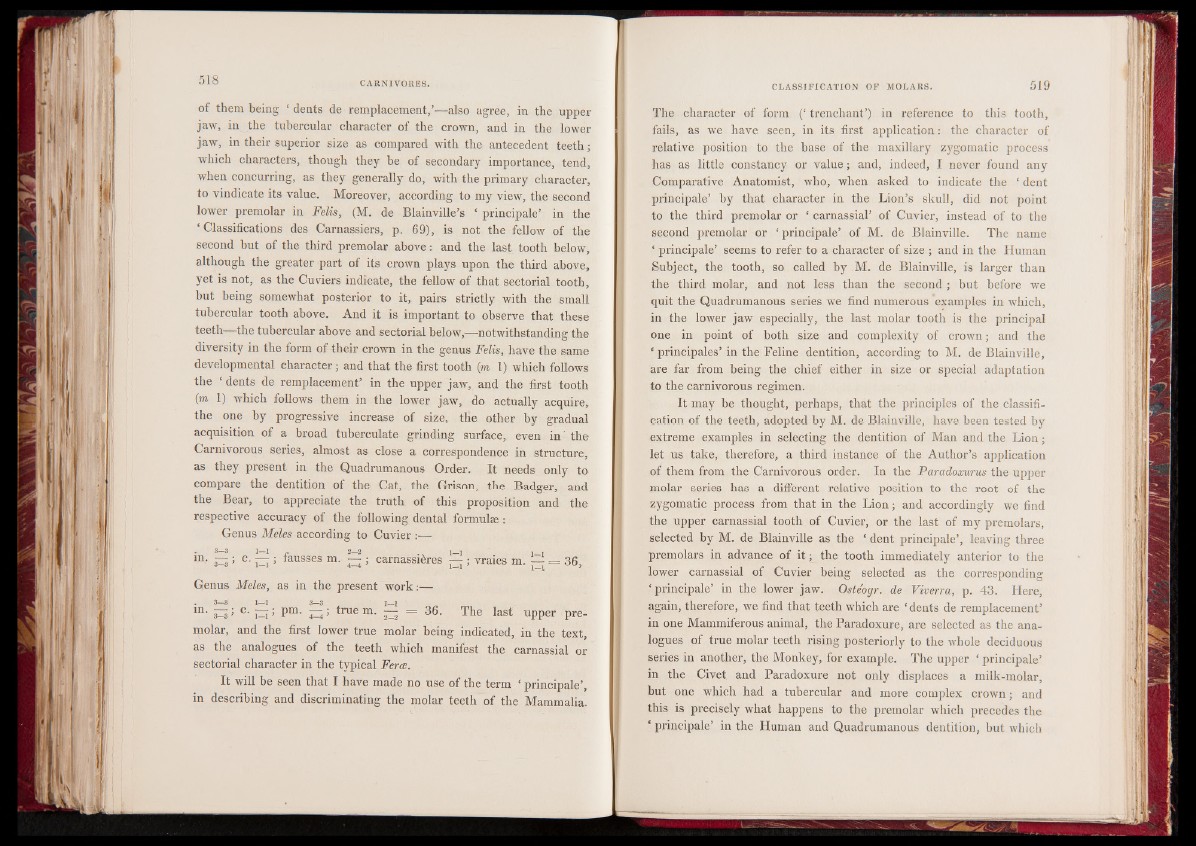
of them being * dents de remplacement,’—also agree, in the upper
jaw, in the tubercular character of the crown, and in the lower
jaw, in their superior size as compared with the antecedent teeth ;
which characters, though they be of secondary importance, tend,
when concurring, as they generally do, with the primary character,
to vindicate its value. Moreover, according to my view, the second
lower premolar in Felis, (M. de Blainville’s ‘ principale’ in the
‘Classifications des Carnassiers, p. 69), is not the fellow of the
second hut of the third premolar above : and the last tooth below,
although the greater part of its crown plays upon the third above,
yet is not, as the Cuviers indicate, the fellow of that sectorial tooth,
hut being somewhat posterior to it, pairs strictly with the small
tubercular tooth above. And it is important to observe that these
teeth—the tubercular above and sectorial below,—notwithstanding the
diversity in the form of their crown in the genus Felis, have the same
developmental character; and that the first tooth (m 1) which follows
the ‘ dents de remplacement’ in the upper jaw, and the first tooth
(m 1) which follows them in the lower jaw, do actually acquire,
the one by progressive increase of size, the other by gradual
acquisition of a broad tuherculate grinding surface, even in the
Carnivorous series, almost as close a correspondence in structure,
as they present in the Quadrumanous Order. It needs only to
compare the dentition of the Cat, the Grison, the Badger, and
the Bear, to appreciate the truth of this proposition and the
respective accuracy of the following dental formulæ :
Genus Meles according to Cuvier :■—
in- i=i ’ c- H '> fausses m. ^ ; carnassières ^ ; vraies m. ^ = 36,
Genus Meles, as in the present work :—
^n- iZi’ c‘ ïZï’ Pm- true m- ^3 = 36. The last upper premolar,
and the first lower true molar being indicated, in the text,
as the analogues of the teeth which manifest the carnassial or
sectorial character in the typical Fera.
It will be seen that I have made no use of the term ‘ principale’,
in describing and discriminating the molar teeth of the Mammalia.
The character of form (‘ trenchant’) in reference to this tooth,
fails, as we have seen, in its first application: the character of
relative position to the base of the maxillary zygomatic process
has as little constancy or value; and, indeed, I never found any
Comparative Anatomist, who, when asked to indicate the ‘ dent
principale’ by that character in the Lion’s skull, did not point
to the third premolar or ‘ carnassial’ of Cuvier, instead of to the
second premolar or ‘principale’ of M. de Blainville. The name
‘ principale’ seems to refer to a character of size ; and in the Human
Subject, the tooth, so called by M. de Blainville, is larger than
the third molar, and not less than the second ; but before we
quit the Quadrumanous series we find numerous examples in which,
in the lower jaw especially, the last molar tooth is the principal
one in point of both size and complexity of crown; and the
I principals’ in the Feline dentition, according to M. de Blainville,
are far from being the chief either in size or special adaptation
to the carnivorous regimen.
It may he thought, perhaps, that the principles of the classification
of the teeth, adopted by M. de Blainville, have been tested by
extreme examples in selecting the dentition of Man and the Lion;
let us take, therefore, a third instance of the Author’s application
of them from the Carnivorous order. In the Paradoxurus the upper
molar series has a different relative position to the root of the
zygomatic process from that in the Lion; and accordingly we find
the upper carnassial tooth of Cuvier, or the last of my premolars,
selected by M. de Blainville as the ‘ dent principale’, leaving three
premolars in advance of it; the tooth immediately anterior to the
lower carnassial of Cuvier being selected as the corresponding
‘principale’ in the lower jaw. Oste'ogr. de Viverra, p. 4 3 . Here,
again, therefore, we find that teeth which are ‘ dents de remplacement’
in one Mammiferous animal, the Paradoxure, are selected as the analogues
of true molar teeth rising posteriorly to the whole deciduous
series in another, the Monkey, for example. The upper ‘ principale’
in the Civet and Paradoxure not only displaces a milk-molar,
but one which had a tubercular and more complex crown; and
this is precisely what happens to the premolar which precedes the
‘ principale’ in the Human and Quadrumanous dentition, but which